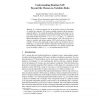Free Online Productivity Tools
i2Speak
i2Symbol
i2OCR
iTex2Img
iWeb2Print
iWeb2Shot
i2Type
iPdf2Split
iPdf2Merge
i2Bopomofo
i2Arabic
i2Style
i2Image
i2PDF
iLatex2Rtf
Sci2ools
CP
2004
Springer
2004
Springer
Understanding Random SAT: Beyond the Clauses-to-Variables Ratio
It is well known that the ratio of the number of clauses to the number of variables in a random k-SAT instance is highly correlated with the instance’s empirical hardness. We consider the problem of identifying such features of random SAT instances automatically using machine learning. We describe and analyze models for three SAT solvers—kcnfs, oksolver and satz—and for two different distributions of instances: uniform random 3-SAT with varying ratio of clauses-to-variables, and uniform random 3-SAT with fixed ratio of clauses-tovariables. We show that surprisingly accurate models can be built in all cases. Furthermore, we analyze these models to determine which features are most useful in predicting whether an instance will be hard to solve. Finally we discuss the use of our models to build SATzilla, an algorithm portfolio for SAT.3
CP 2004 | Instance’s Empirical Hardness | Programming Languages | Random K-SAT Instance | Random Sat Instances |
| Added | 01 Jul 2010 |
| Updated | 01 Jul 2010 |
| Type | Conference |
| Year | 2004 |
| Where | CP |
| Authors | Eugene Nudelman, Kevin Leyton-Brown, Holger H. Hoos, Alex Devkar, Yoav Shoham |
Comments (0)

